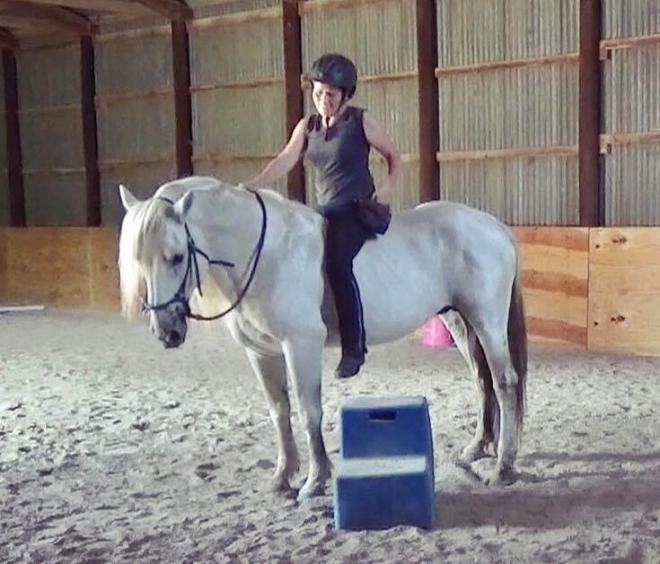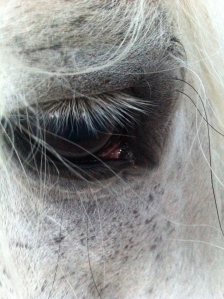
Tarot giving a lesson to a student during a clinic here at Idle Moon.
The first thing that happened was I held a clinic here on my farm, and he was able to participate, as a school horse, in an arena full of people. Just a few years earlier, if anyone but me was in the arena with him he would be tense, on edge and prone to big, cantering bolt-y spooks. Extra people were always a concern for him because they reminded him of situations where multiple people had worked together to control him. But this year he let go of that old conditioning.
As if that wasn’t enough, he was additionally comfortable working with someone other than me at length. His ability to absorb stress and novelty had hugely expanded. In effect, his world-view had changed. His old predictors for danger and self-preservation were consistently superseded by his new, positive associations he had learned here.
The second thing was more subtle, but just as important. When I got home from my “study abroad” trip from the Netherlands, I took out my horses one by one to say hello and introduce them to some of what I had learned. When I started to work with him on some of the balances, I had the immediate sense of time turning to water, of the world softening, opening, and I knew that if I did not travel with him as deeply as possible, there would be lovely things he offers I would never get to know. It was time to be serious now.
When I re-visited our work at the mounting block, I found he remembered everything exactly as if we had rehearsed it the day before. I could climb up the block, take up the reins, throw my leg over and sit, click, climb off and feed. He even threw in lovely posture to sweeten the deal.

Relaxed and focused at the mounting block.
He was comfortable with me getting on, but I had never taught him how to take food from my hand while I was up on his back. Real riding was going to require that he was comfortable taking food from me while I was up. In addition, because Tarot had bolted before under a rider, it was important that I paid attention to every detail as I rebuilt a reinforcement history for ridden games. Structuring each piece so he felt safe and successful would guide him toward feeling being a riding horse would be something he could enjoy and be confident about. I didn’t want any carelessness on my part in the beginning to sabotage what might be possible for us.
Initially, when I clicked and tried to feed from his back the first few times, I had grain in my hand, and it was hard for him to get a hold of all the grain. A lot of it fell onto the ground and he stopped trying to turn his head to get it. Too hard! My friend gave me the idea of trying big, easy to grab apple treats, so we tried again with those.
My goals with these initial repetitions are modest. Click Tarot for standing still, feed him so he can be successful taking a reinforcer, let him chew, click him for straightening his head back in the center of his neck, click and repeat. In the video you can see him practicing food acquisition, as well as the little “tour” we take around the object circle after our mounting practice. The walk around the circle gives both of us a little break in between repetitions and sets us up geographically for where we will go when we do start moving.
I was happy with our progress, but I wanted to see if once I was on his back, I could ask him for an operant behavior. I chose his “rein” behavior, which cues him to lower his head a touch when I pick up the reins. We’ve practiced it over and over at the mounting block and it’s a high probability behavior for him. In the next video, you’ll see me get on Tarot, click him for allowing the sit, feed and then cue a slight head lowering through a verbal cue and slide down the rein. It transfers just beautifully! In addition, I add in a shoulder tap to cue him about the side the reinforcer will be delivered from. Let’s watch:
All these details can seem like overkill. You are on! Get riding! Except, what do you have to rely on if things go wrong? Right now, we are building a lovely loop where we can relax in the halt and use well established head lowering and a high rate of reinforcement to take a break or re-establish calm should we need it. These are the details that are the scaffolding of trust and relaxation.
It’s easy to see that Tarot’s thick neck makes it hard for him to swing around and get the treat from my hand. There is a lot of sideways movement in that gesture. But, it’s also reassuring that he can come so far out of balance and go back into balance without panicking. I’m sure over a few more sessions we will refine this together and it will already look different than the video above. But first approximations are good to have on video so you can compare as things evolve.
This week we will practice a few more rounds of our loop at the mounting block, and after that, we will begin forward movement mat to mat.
Now, at this benchmark, I dream only of seven more years to explore this world we have mined, together.

Playing at liberty after our session.
If you enjoyed reading this blog, head on over to my Patreon page and learn more about becoming a patron. Join my horse friendly training community and support me writing more material like this, and learn about online courses I am developing!





